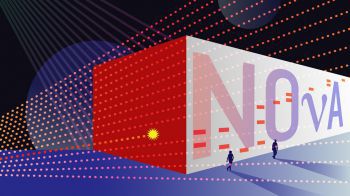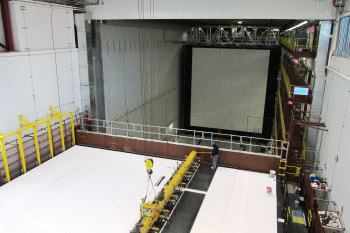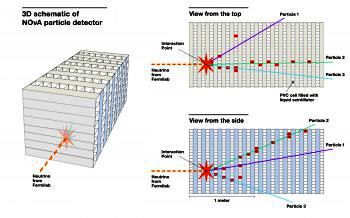“Full steam ahead” for Sussex physicists as neutrino detectors completed
A major international experiment, involving University of Sussex physicists, into the mysterious cosmic particles known as neutrinos is now up and running.

 Workers at the NOvA hall in northern Minnesota assemble the final block of the far detector in early February 2014, with the nearly completed detector in the background.
Workers at the NOvA hall in northern Minnesota assemble the final block of the far detector in early February 2014, with the nearly completed detector in the background.
 A graphic representation of one of the first neutrino interactions captured at the NOvA far detector in northern Minnesota. The dotted red line represents the neutrino beam.
A graphic representation of one of the first neutrino interactions captured at the NOvA far detector in northern Minnesota. The dotted red line represents the neutrino beam.
After five years, construction has just been completed on two massive detectors in the USA, placed 500 miles apart, designed to detect and study one of nature’s most elusive subatomic particles.
Neutrinos are abundant in the atmosphere but they have barely any mass and very rarely interact with other matter. Many of the neutrinos around today are thought to have originated in the big bang – and studying them could yield crucial information about the early moments of the universe.
Dr Jeff Hartnell, who is leading the Sussex team, says: “It’s fantastic to have finished construction of the detectors and to have seen neutrinos throughout.
“It’s now full steam ahead to catch as many neutrinos interacting in our detectors as possible. We really can’t wait to see what our data analysis will reveal about the fundamental behaviour of these elusive particles.”
Physicists theorise that the big bang created equal amounts of matter and antimatter. When corresponding particles of matter and antimatter meet, they annihilate one another. But somehow we’re still here, and antimatter, for the most part, has vanished.
The best measurements to date show that matter and antimatter behave almost identically and so can’t explain how we’re all here. Scientists believe that neutrinos could hold the key to understanding this mystery.
For the next six years, researchers will fire 100-thousand-billion neutrinos every second straight through the Earth in a beam between the two detectors, the larger of which is 60 metres long and weighs 14,000 tons.
Scientists expect to catch only a few neutrinos each day, so rarely do the particles interact with other matter. It is a task described by Fermilab as “like searching all of North and South America for one person”.
Six Sussex researchers are the only UK scientists working on the international NoVA experiment at Fermilab, based near Chicago.
Since joining the experiment two years ago, the Sussex team has played a crucial role in calibrating and fine-tuning the detectors.
Sussex’s Dr Matthew Tamsett has been appointed as head of the group of 10-20 international collaborators who will process the raw data from the detectors. This extensive crunching of data will require 600,000 hours of computing time and 250 terabytes of disk space to extract a result for publication.
The Sussex team is also heavily involved with analysing the data and is completed by Tristan Blackburn, Jonathon Davies, Luke Vinton and Dr Bruno Zamorano.
This video by Fermilab shows the precision of the ‘far’ detector, spotting neutrino interactions amidst the cosmic ray noise.
